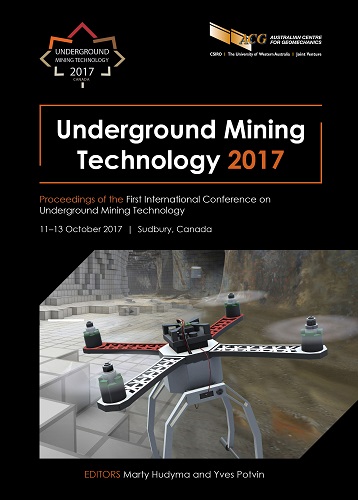Telerobotics for hang-up assessment and removal – an idea whose time has come

|
Authors: Baiden, G |
DOI https://doi.org/10.36487/ACG_rep/1710_48_Baiden
Cite As:
Baiden, G 2017, 'Telerobotics for hang-up assessment and removal – an idea whose time has come', in M Hudyma & Y Potvin (eds), UMT 2017: Proceedings of the First International Conference on Underground Mining Technology, Australian Centre for Geomechanics, Perth, pp. 597-607, https://doi.org/10.36487/ACG_rep/1710_48_Baiden
Abstract:
The removal of rock blockages in drawpoints in mining operations has long been a risky undertaking, especially in high overhead conditions. In fact, the assessment of where to place those charges has been difficult due to the lack of visibility and safe access to the area. Thus, the traditional practise of the wedging of long poles with explosives on them, keeping the operator in as safe a location as possible, has been one of the tried and true methods in attempting to remove blockages. Unfortunately, this is less than perfect, usually taking several attempts to achieve the blockage removal. Each successive attempt can result in an even more dangerous condition for the worker and/or damage to the mine, often due to successively larger amounts of explosives. Over the years, different ideas have been attempted to change this process and reduce the inherent safety risks. Some of the technologies that have been attempted ranged from projectiles fired at the hang-up, to large, cumbersome arms, to massive amounts of explosives, each with their own safety risks resulting in dangerous situations for the miner and the mine. We have reached a point where combining mining problems with gaming technology and robots can achieve results that the mining industry has struggled to achieve so far. In this case, the safe assessment and removal of hang-ups and oversize could be possible by combining Penguin’s proprietary GPS-denied positioning system with a six-degree of freedom telerobot, virtual gaming and teleoperation over a wireless network. Penguin Automated Systems has developed a robot system capable of working in a rock blockage safely. The idea draws on the latest in telerobotics technology combined with 3D scanning and underground geospatial positioning. The hang-up removal is performed by scanning the inside of the hang-up to rapidly develop a geospatially 3D model. The 3D model enables the picking of the ‘keystone’. The robot arm on the robot then uses this 3D virtual model of the robot system and the drawpoint to locate and load the hole to clear the hang-up.
Keywords: hang-up, telerobotic, blasting, assessment, removal
References:
Chitombo, GP 2010, ‘Cave mining – 16 years after Laubscher’s 1994 paper ‘Cave mining – state of the art’’, in Y Potvin (ed.), Proceedings of the Second International Symposium on Block and Sublevel Caving, Australian Centre for Geomechanics, Perth, pp. 45–61.
Laubscher, DH 1994, ‘Cave mining – the state of the art’, Journal of the South African Institute of Mining and Metallurgy, vol. 94, no. 10, pp. 279–293.
© Copyright 2025, Australian Centre for Geomechanics (ACG), The University of Western Australia. All rights reserved.
View copyright/legal information
Please direct any queries or error reports to repository-acg@uwa.edu.au
View copyright/legal information
Please direct any queries or error reports to repository-acg@uwa.edu.au